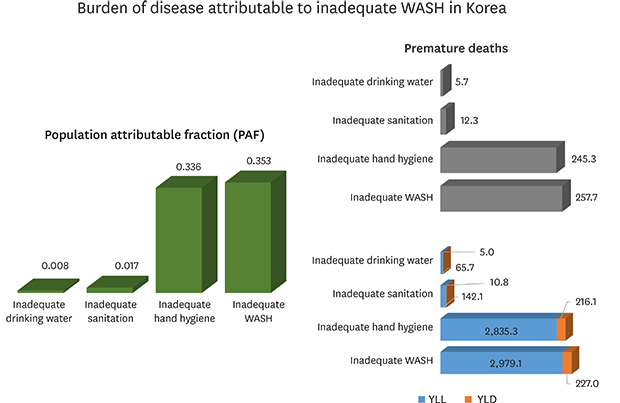2. Hunter PR, MacDonald AM, Carter RC. Water supply and health. PLoS Med. 2010; 7(11):e1000361.

3. Mara D, Lane J, Scott B, Trouba D. Sanitation and health. PLoS Med. 2010; 7(11):e1000363.

4. Wolf J, Prüss-Ustün A, Cumming O, Bartram J, Bonjour S, Cairncross S, et al. Assessing the impact of drinking water and sanitation on diarrhoeal disease in low- and middle-income settings: systematic review and meta-regression. Trop Med Int Health. 2014; 19(8):928–942.
6. Freeman MC, Stocks ME, Cumming O, Jeandron A, Higgins JP, Wolf J, et al. Hygiene and health: systematic review of handwashing practices worldwide and update of health effects. Trop Med Int Health. 2014; 19(8):906–916.
7. World Health Organization. Preventing Disease through Healthy Environments: a Global Assessment of the Burden of Disease from Environmental Risks. Geneva: World Health Organization;2016.
9. Prüss-Ustün A, Bartram J, Clasen T, Colford JM Jr, Cumming O, Curtis V, et al. Burden of disease from inadequate water, sanitation and hygiene in low- and middle-income settings: a retrospective analysis of data from 145 countries. Trop Med Int Health. 2014; 19(8):894–905.

11. Forouzanfar MH, Alexander L, Anderson HR, Bachman VF, Biryukov S, Brauer M, et al. Global, regional, and national comparative risk assessment of 79 behavioural, environmental and occupational, and metabolic risks or clusters of risks in 188 countries, 1990–2013: a systematic analysis for the Global Burden of Disease Study 2013. Lancet. 2015; 386(10010):2287–2323.
12. Clasen T, Pruss-Ustun A, Mathers CD, Cumming O, Cairncross S, Colford JM Jr. Estimating the impact of unsafe water, sanitation and hygiene on the global burden of disease: evolving and alternative methods. Trop Med Int Health. 2014; 19(8):884–893.

13. World Health Organization. WHO Methods and Data Sources for Global Burden of Disease Estimates 2000??011. Geneva: World Health Organization;2013.
16. Lee MS, Hong SJ, Kim YT. Handwashing with soap and national handwashing projects in Korea: focus on the National Handwashing Survey, 2006–2014. Epidemiol Health. 2015; 37:e2015039.

17. Yu J, Wang C, Shin I, Kim D, Park K. Analysis of waterborne pathogenic bacteria among total coliform positive samples in the groundwater of Chungcheongnam-do province, Korea. J Environ Health Sci. 2016; 42(3):189–195.

18. Sahoo PK, Kim K, Powell M. Managing groundwater nitrate contamination from livestock farms: implication for nitrate management guidelines. Curr Pollution Rep. 2016; 2(3):178–187.

19. Wen Y, Schoups G, van de Giesen N. Organic pollution of rivers: combined threats of urbanization, livestock farming and global climate change. Sci Rep. 2017; 7(1):43289.

21. Lee GC, Jheong WH, Jung GS, Oh SA, Kim MJ, Rhee OJ, et al. Detection and molecular characterization of human noroviruses in Korean groundwater between 2008 and 2010. Food Environ Virol. 2012; 4(3):115–123.

22. Kim JH, Lee DH, Joo Y, Zoh KD, Ko G, Kang JH. Identification of environmental determinants for spatio-temporal patterns of norovirus outbreaks in Korea using a geographic information system and binary response models. Sci Total Environ. 2016; 569-570:291–299.

23. Park SH, Kim EJ, Lee JH, Choi SS, Kim MS, Jung SS, et al. Molecular characterization of hepatitis A virus isolated from acute gastroenteritis patients in the Seoul region of Korea. Eur J Clin Microbiol Infect Dis. 2009; 28(10):1177–1182.

24. Cheong HK, Park SK, Ki M, Lee K. Six year national trend of childhood aseptic meningitis incidence in Korea, 1996–2001. Korean J Epidemiol. 2008; 30(2):252–262.

25. Park SK, Cheong HK, Ki M, Son YM, Kim H. Assessment of the availability of health insurance data for epidemiologic study of childhood aseptic meningitis. Korean J Prev Med. 2003; 36(4):349–358.
26. Lee YA, Oh SH, Hong SJ, Kim YH, Moon HN, Hong CY. Hand, foot and mouth disease associated with the aseptic meningitis in Seoul, 1990. J Korean Pediatr Soc. 1993; 36(6):842–849.
27. Murphy HM, Pintar KD, McBean EA, Thomas MK. A systematic review of waterborne disease burden methodologies from developed countries. J Water Health. 2014; 12(4):634–655.

28. Norman G, Pedley S, Takkouche B. Effects of sewerage on diarrhoea and enteric infections: a systematic review and meta-analysis. Lancet Infect Dis. 2010; 10(8):536–544.

29. Aiello AE, Coulborn RM, Perez V, Larson EL. Effect of hand hygiene on infectious disease risk in the community setting: a meta-analysis. Am J Public Health. 2008; 98(8):1372–1381.

30. Levy K, Klein M, Sarnat SE, Panwhar S, Huttinger A, Tolbert P, et al. Refined assessment of associations between drinking water residence time and emergency department visits for gastrointestinal illness in Metro Atlanta, Georgia. J Water Health. 2016; 14(4):672–681.

31. Tinker SC, Moe CL, Klein M, Flanders WD, Uber J, Amirtharajah A, et al. Drinking water residence time in distribution networks and emergency department visits for gastrointestinal illness in Metro Atlanta, Georgia. J Water Health. 2009; 7(2):332–343.

32. Curtis V, Cairncross S. Effect of washing hands with soap on diarrhoea risk in the community: a systematic review. Lancet Infect Dis. 2003; 3(5):275–281.

33. Roberts L, Jorm L, Patel M, Smith W, Douglas RM, McGilchrist C. Effect of infection control measures on the frequency of diarrheal episodes in child care: a randomized, controlled trial. Pediatrics. 2000; 105(4 Pt 1):743–746.

34. Black RE, Dykes AC, Anderson KE, Wells JG, Sinclair SP, Gary GW Jr, et al. Handwashing to prevent diarrhea in day-care centers. Am J Epidemiol. 1981; 113(4):445–451.
35. Hunter PR, Pond K, Jagals P, Cameron J. An assessment of the costs and benefits of interventions aimed at improving rural community water supplies in developed countries. Sci Total Environ. 2009; 407(12):3681–3685.











 PDF
PDF Citation
Citation Print
Print






 XML Download
XML Download